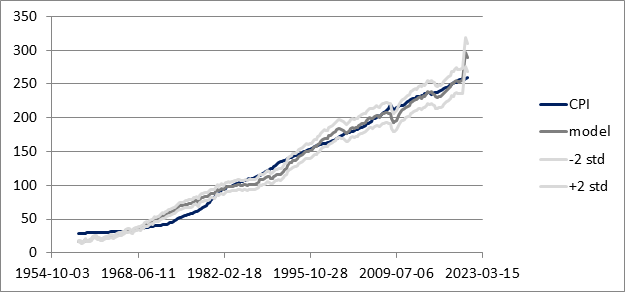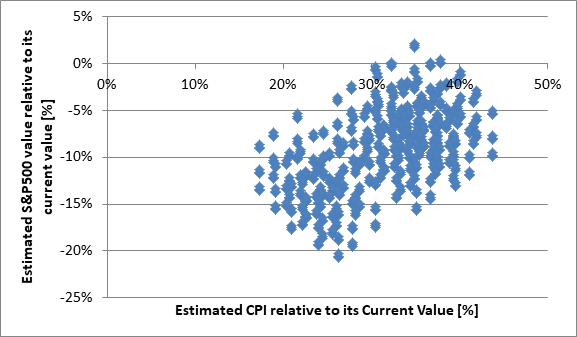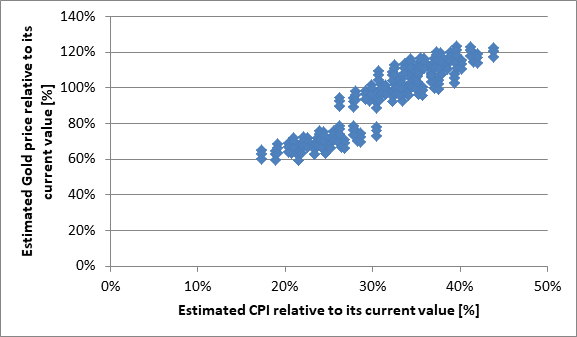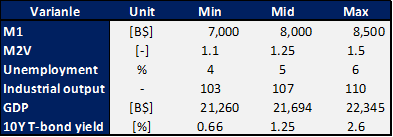|
Cash is trash. Considering all the money that has been printed by the Federal Reserve in 2020, this strong statement made by Ray Dalio in 2020 is more than justified. The questions are: what rate of inflation should we expect? Is there anything we can do about it to protect our hard earned money? In this article we will:
Inflation is not just about money printing, there are three more factors affecting its value. CPI could be thought as a function of: money stock index (M1), velocity of the money stock (M2V) (i.e. how fast money changes hands), unemployment rate and industrial output. Increasing these four independent variables increases the inflation. A simple linear regression model was built using these parameters. The model has an accuracy of 99% (R2) and a P-value below 0.05 for all the regression coefficients. Two times the average error between modeled and actual data has been calculated to be 7.18%. The actual and modeled CPI is shown in Figure 1. Figure 1: Actual and modeled consumer price index. Where is the inflation heading? To answer to this question, we need to understand the value of all the variables affecting the inflation by the end of 2021. It is estimated that M1 might reach a level of 8.2 trillion dollars. The estimation is based both on the current trend as well as the stimulus package announced by the Government. Due to the current restrictions and “normal” life not expected to be back before 2022/2023, it is estimated that M2V will not increase in value and stays relatively flat at 1.13 throughout 2021. The unemployment level has been drastically decreasing in the last few months. If the trend continues, it will not be unlikely that it might reach 5.7% by the end of 2021. The unemployment will not reach the pre-COVID levels because, due to the current and projected restrictions, several sectors will not be able to operate again at full speed. The industrial output is expected to increase by 3.5%, reaching a value of 107.23 point. For the same reasons mentioned so far, not a full recovery from its peak value of 110.11 points . Given these assumptions, using the above mentioned model, it is estimated that by the end of 2021, the CPI might reach 353 point: 35% higher than the current level (261.78). If the prices would increase by 35% by the end of 2021 (or even a fraction of this estimate), this would mean that the cash in our bank accounts might lose its purchasing power. To make an example, imagine you have $50,000 in your saving account in 2020. By the end of 2021, the purchasing power of this $50,000 would be equivalent to $32,500 ($50,000 * 35%). By now the statement “cash is trash” should make more sense. What to do about it? Bond yields are currently very low; ca.1.25%. It would roughly take 35 years to recover this inflation loss while assuming there will not be any inflation increase in the future. Not the best way to go. How about investing in an index fund that follows the S&P500? To do that we have estimated the value of the S&P500 based on: gross domestic product (GDP), medium term Treasury bond yield, CPI, M1, M2V, unemployment rate and industrial output. This linear regression model is an updated version of the model we have presented in this article; link here. Assuming that the GDP will rise by 1.0% in 2021 while the bond yield will stay at 1.25% then it is estimated that by the end of 2021, the S&P500 should be valued: 3,488 points plus/minus 12.52%. The current market value of the S&P500 is 3,901 points. This means that the equity market might not be the most suited place where to put your hard saved money. What is left? Bitcoin and gold. I’ll focus on the yellow metal since my competencies on crypto currencies are limited. Our linear regression gold model takes as independent variables: the S&P500 value, M1 and CPI. More details on the model can be found in here. With the numbers estimated so far, gold might reach by the end of the year 3,857 USD/oz plus/minus 279 USD/oz. Currently gold is at 1,844 USD/oz meaning that there is an upside potential of 209%. The number is high enough thus offering an effective protection mechanism against the damage that a potential increase in inflation might create. Because the current conclusion is based on several assumptions, a sensitivity analysis has been done on the assumptions that have been made. Table 1 shows the sensitivity boundary values of each of the six variables. A total of 729 combinations were created and analyzed. In Figure 1 and Figure 2, it is shown the estimated value of the S&P500 and gold as a function of the estimated value of the CPI at the end of 2021. These three parameters have been normalized relative to their current levels. Figure 2 shows that the CPI might increase between 15 and 45%, unfortunately in the vast majority of the cases the S&P500 would have a negative return in 2021; at worst -20%. Gold, Figure 3, shows that might experience an increase in value between 60 and 120%. The sensitivity analysis still support the main finding: inflation might increase and gold should be the best asset to invest in and avoid that our money will lose their value. Figure 2: Estimated CPI vs. estimated S&P500 value both relative to current valuation. Scatter plot of the sensitivity analysis. Figure 3: Estimated CPI vs. estimated gold price both relative to current valuation. Scatter plot of the sensitivity analysis. Table 1: Sensitivity analysis boundary values for the variables used to estimate: CPI, S&P500 value and gold price. In conclusion, in this work we have presented that is possible to model the consumer price index. The model indicates that by the end of the year the inflation might substantially increase as result of the money that has been printed, industrial output and unemployment. To avoid losing the value of the money, investing in bonds or the S&P500 will not provide a hedge. It is projected that the S&P500 might lose ground in 2021. Gold offers an effective hedge against the projected rise in inflation. The estimated increase in gold value should more than balance the decrease in value of the cash due to the rise in inflation; it will actually result in a value increase of the invested capital.
|
|
|
|
Questions?Contact us here.
DisclaimerThe information, analysis, data and articles provided in this and through this website are for informational purpose only. Nothing should be considered as an investment advice. Alpha Growth Capital LLC does not make any recommendation to buy, sell or hold any security or position. The website and information provided through it are marketed “as is”. There is no guarantee that anything presented and provided on this and through this website is complete, accurate and correct. Relying on the information provided on this website and through its communication channels is done entirely at the individual own risk. The owner of Alpha Growth Capital is not a registered investment advisor under any security law and nothing provided in this and through this website should be interpreted as a solicitation to buy, hold or sell any mentioned financial product or service. Past performance is not indicative of future results. Any financial decision is at the sole responsibility of the individual.
By navigating in this website, you agree to its Terms & Conditions |




